Hold your breath as ancient prophecies reveal a cataclysmic end, where the ultimate battle decides the fate of humanity.
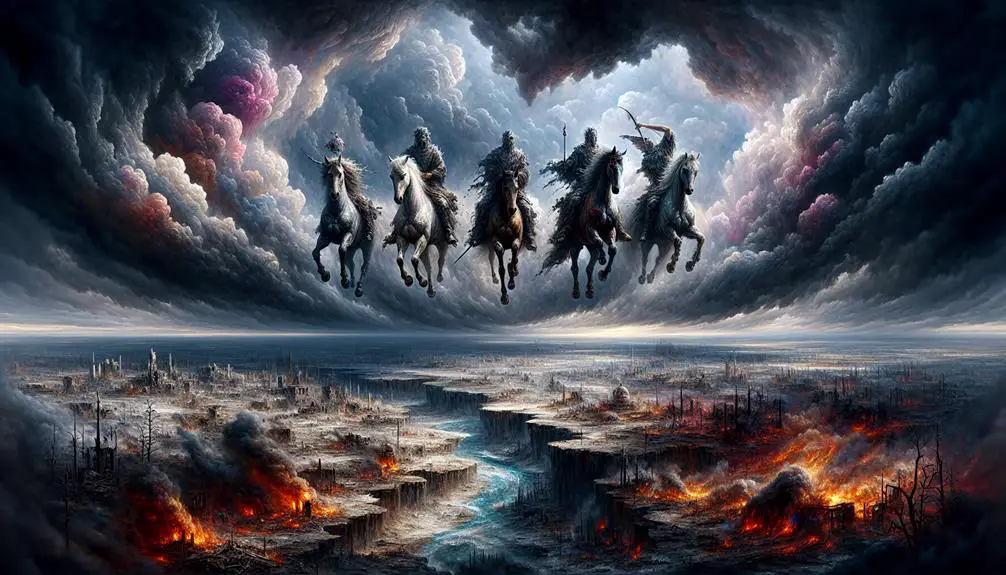
How Will the World Be Destroyed in the Bible
Well, if you've ever thought your Monday couldn't get any worse, the Bible's blueprint for the end times might put things in perspective. You're in for a journey through prophetic visions that sound more like a blockbuster film script than ancient scripture.
Starting with the rise of the Antichrist, moving through the catastrophic opening of the Seven Seals, and enduring the ear-shattering sound of the Trumpets, you'll witness the world teeter on the brink. The Battle of Armageddon then takes center stage, climaxing into what can only be described as the ultimate showdown.
But, it's the Final Judgement that's the true game-changer. Stick around, and you might just find out whether there's a twist at the end of this tale.
Key Takeaways
- Biblical prophecy outlines a sequence of cataclysmic events, like the Seven Seals and Trumpet Judgments, leading to the world's destruction.
- The Battle of Armageddon signifies a major battle between good and evil, culminating in divine intervention and the ultimate destruction of evil.
- The Final Judgment separates the righteous from the wicked, implying that moral and spiritual decisions impact the world's end.
- The culmination of these events ushers in the restoration of a new, sin-free creation, marking the end of the current world as prophesied.
The Rise of the Antichrist
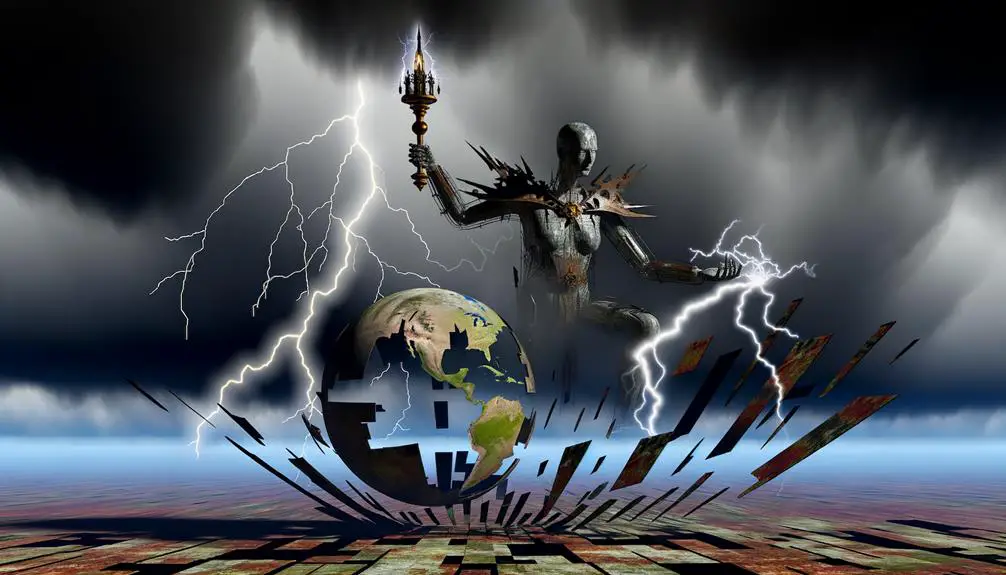
In biblical prophecy, the emergence of the Antichrist marks a pivotal moment in end-times narratives, symbolizing the onset of a period of widespread deception and turmoil. This figure's origins are deeply rooted in Christian eschatology, where you'll find a blend of interpretations that underscore his role as the epitome of global deception. Scholars and theologians have long debated the Antichrist's emergence, seeking to understand how this entity embodies the ultimate adversary in a world teetering on the brink of moral and spiritual collapse.
The Antichrist's rise is characterized by an unparalleled ability to deceive, wielding power and influence to mislead nations and individuals away from truth. He's prophesied to perform signs and wonders, convincing many of his legitimacy and divine authority. This global deception isn't merely about leading astray but about fundamentally altering perceptions of morality, truth, and faith. The Antichrist's ascendancy is thus not just a political or military coup but a profound spiritual upheaval.
Understanding the Antichrist's origins requires a nuanced examination of biblical texts, where you'll find references to this figure not as a mere mortal but as a symbol of ultimate rebellion against the divine. This analysis reveals the Antichrist as a culmination of mankind's defiance against God, manifested through a charismatic leader capable of global influence.
As you delve deeper into this subject, it's crucial to recognize the Antichrist's role in the broader eschatological framework. His rise isn't an isolated event but a significant marker of the approaching end, signaling a time when discernment and faith become paramount in resisting the allure of his deception.
The Seven Seals Unveiled
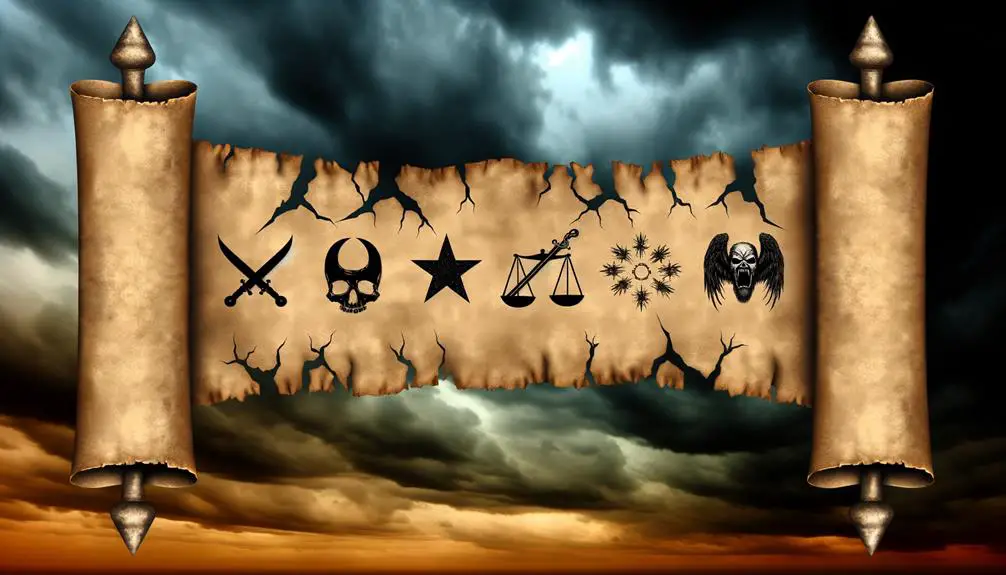
Following the rise of the Antichrist, the unveiling of the Seven Seals marks a critical juncture in biblical prophecy, heralding a sequence of cataclysmic events that further unfold the narrative of the end times. This phase is rich in heavenly symbolism, with each seal representing distinct phases or events in the apocalyptic timeline.
You'll find that the interpretations of these seals have been the subject of extensive theological analysis, aiming to understand their broader implications. The first four seals, often referred to as the Four Horsemen of the Apocalypse, symbolize conquest, war, famine, and death, respectively. Each horseman introduces a new layer of tribulation upon the earth, intertwining with historical and future predictions of global turmoil.
The fifth seal shifts focus, highlighting the martyrdom and persecution of the faithful, indicating a period of intense suffering for believers. This is followed by the sixth seal, which portrays cosmic disturbances and cataclysms, suggesting a direct divine intervention in the natural order.
Let's emphasize the key aspects in a list:
- Conquest: The first seal introduces a figure on a white horse, symbolizing the spread of conflict and dominion.
- War: The second seal brings a red horse, representing widespread warfare.
- Famine: The black horse of the third seal signifies scarcity and economic collapse.
- Death: The pale horse of the fourth seal foretells mass mortality.
The seventh seal, enveloped in silence, serves as a prelude to further judgments, marking a pause before the narrative progresses to the Wrath of the Trumpets. Herein, the intricate layering of heavenly symbolism and seal interpretations reveals a structured approach to eschatology, emphasizing the sequential unraveling of end-time events.
The Wrath of the Trumpets
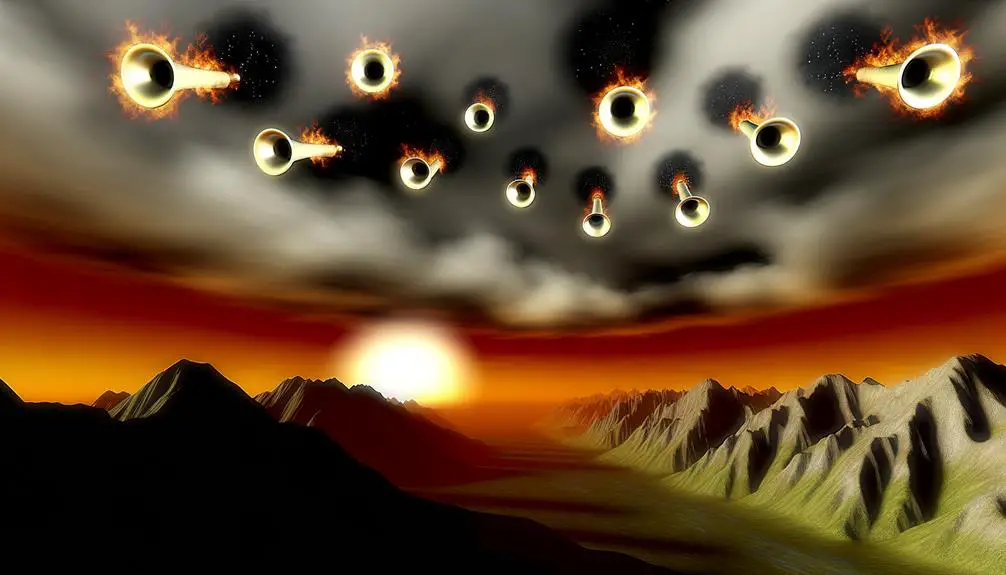
Upon the breaking of the seventh seal, we encounter the Wrath of the Trumpets, a series of divine judgments manifesting through celestial and terrestrial phenomena, each announced by an angelic trumpet blast. This sequence, part of the heavenly orchestra, signals the intensification of celestial warnings aimed at humanity. The unfolding events underscore a divine orchestration, where each trumpet serves as a harbinger of specific judgments.
Trumpet |
Judgment Manifestation |
|---|---|
First |
Hail and fire mixed with blood, casting a third of the earth into flames. |
Second |
A great mountain burning with fire plunges into the sea, turning a third of the sea into blood. |
Third |
A great star, named Wormwood, falls from heaven, poisoning a third of the earth's freshwater sources. |
Fourth |
A third of the sun, moon, and stars are darkened, leading to a significant decrease in daylight. |
Fifth |
A bottomless pit opens, releasing locusts that torment those without the seal of God on their foreheads. |
These trumpet judgments reveal a pattern of escalating severity, emphasizing the consequences of human iniquity and the urgency of repentance. They serve as celestial warnings, aiming to rouse humanity from its complacency and provoke a reflection on its actions. As part of the heavenly orchestra, these trumpet blasts are not just punitive measures but also merciful calls for humanity to return to divine grace before the final judgment. Analyzing these events, one gains insight into the multifaceted nature of divine justice, which balances retribution with opportunities for redemption.
The Battle of Armageddon
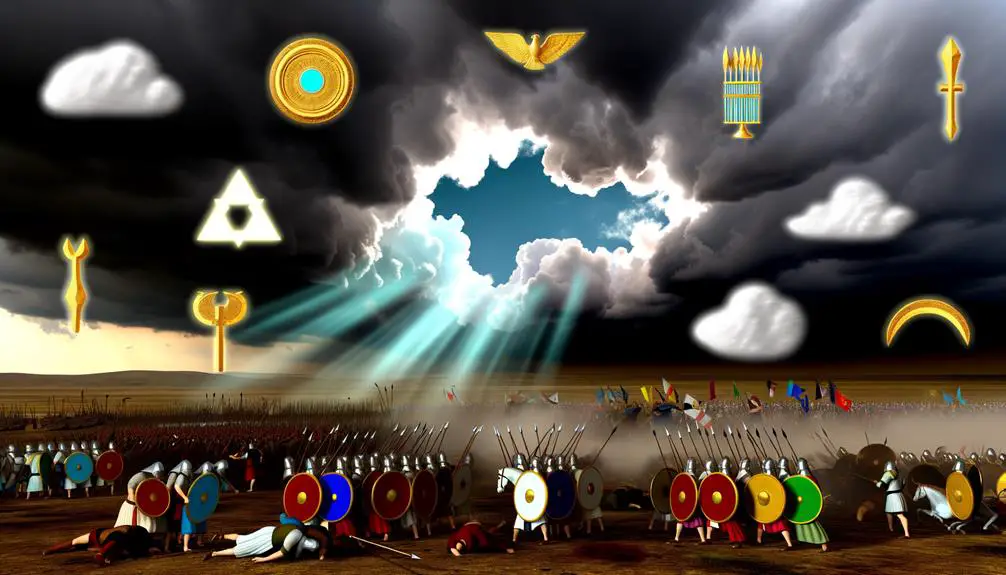
As the narrative unfolds, one encounters the Battle of Armageddon, a pivotal moment where forces of good and evil clash in a decisive confrontation prophesied within the biblical text. This event, symbolically tied to the ancient site of Megiddo, reflects the culmination of human history's spiritual and moral conflicts through the lens of global warfare.
Megiddo's significance can't be overstated. Historically, it has been the site of numerous battles due to its strategic location at the crossroads of key trade routes. In the context of the Battle of Armageddon, it symbolizes the ultimate battleground, where the fate of humanity is determined. The biblical portrayal of this battle serves as a metaphor for the final struggle between divine forces and the powers of darkness.
The Battle of Armageddon is characterized by several key elements:
- Global Involvement: It's depicted as a conflict involving nations from across the earth, highlighting its scope as encompassing all of humanity.
- Divine Intervention: The battle is ultimately decided by the direct intervention of divine forces, signifying the supremacy of spiritual over earthly power.
- Moral and Spiritual Resolution: The conflict represents the resolution of long-standing moral and spiritual dilemmas facing humanity.
- Prophetic Fulfillment: The occurrence of this battle signifies the fulfillment of biblical prophecy, marking a critical juncture in the divine plan for the world.
Analyzing the Battle of Armageddon requires understanding its symbolic importance within the biblical narrative. It's not merely a prediction of global warfare but a representation of the ultimate victory of good over evil, encapsulated within the prophetic vision of the end times.
The Final Judgement
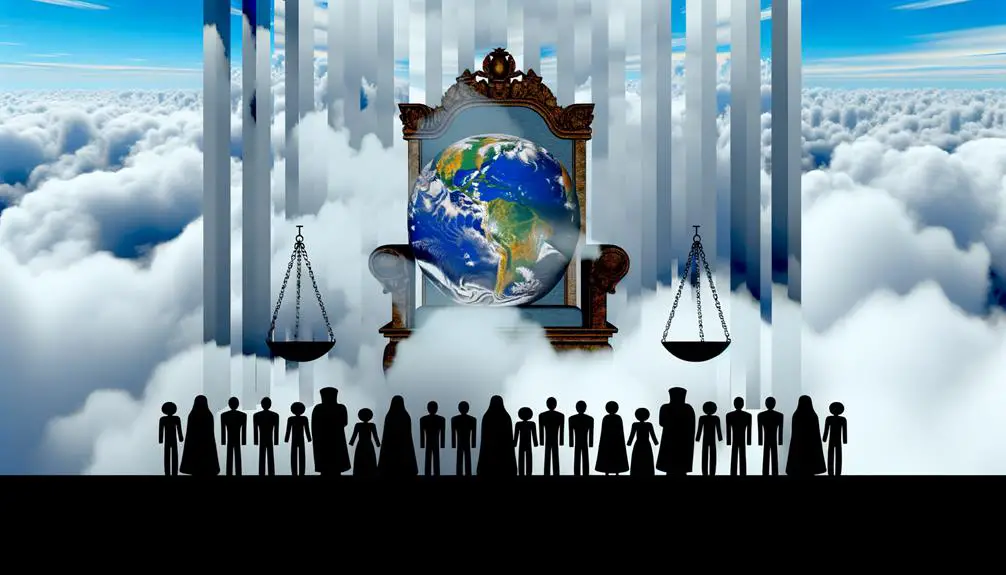
In biblical eschatology, the Final Judgment represents a pivotal moment when every individual faces divine assessment based on their earthly lives. This event carries profound implications, as it determines the eternal fate of each soul. Grounded in scripture, the concept emphasizes accountability for actions, thoughts, and decisions made during one's lifetime. It's a culmination of divine justice, where the righteous are rewarded and the wicked face punishment. This dichotomy underscores the gravity of the Final Judgment, highlighting its role as a decisive event with eternal consequences.
Central to understanding the Final Judgment is recognizing the balance between divine justice and divine mercy. Scripture reveals that while justice demands accountability for sin, divine mercy offers redemption and forgiveness to those who repent and believe. This interplay suggests that the Final Judgment isn't merely about retribution; it's also an expression of God's loving desire to restore and reconcile humanity to Himself.
The implications of the Final Judgment extend beyond individual outcomes. It signifies the restoration of moral order and the fulfillment of God's plan for creation. In this sense, the event isn't only about the fate of individuals but also about the vindication of God's righteousness and the establishment of His kingdom. The Final Judgment, therefore, encapsulates the hope of a redeemed creation, free from sin and suffering, where divine justice and mercy are perfectly manifested.
Analyzing the Final Judgment from this perspective offers insight into its significance within biblical eschatology as the ultimate manifestation of God's justice, mercy, and love. It challenges individuals to reflect on their lives in light of eternal consequences and the transformative power of divine mercy.
Frequently Asked Questions
How Does the Bible Describe the Creation of a New Heaven and a New Earth Following the World's Destruction?
In the Bible, after the world's end, you'll find a vivid depiction of renewal symbolism through the creation of a new heaven and earth.
This narrative isn't just fantastical; it's deeply rooted in themes of environmental stewardship, urging you to reflect on the care and preservation of our world.
It's a powerful call to action, suggesting that renewal and redemption are possible, emphasizing the importance of our role in nurturing and protecting our environment.
What Role Do Angels and Other Celestial Beings Play Throughout the Process of the World's Destruction?
In the intricate angel hierarchy, celestial beings play pivotal roles in the unfolding events. They're not just bystanders; they're engaged in celestial warfare, acting under divine commands.
You'll find them executing judgments, delivering messages, and leading armies in the spiritual realm. Their actions are crucial, impacting the earthly and heavenly realms alike.
This interaction between the celestial and the terrestrial highlights their significant role in the overarching narrative.
Are There Specific Signs or Events in the Modern World That Some Interpret as Indications of the Approaching Biblical End Times?
You're looking for signs in modern events that might hint at the biblical end times. Climate change and technological advancements often come up in these discussions.
Scholars analyze how unprecedented environmental shifts and rapid tech growth could align with ancient prophecies. While it's tempting to draw direct connections, it's crucial to approach such interpretations with caution, recognizing the complex interplay between religious texts and contemporary global developments.
How Does the Concept of Free Will Interact With the Prophesied Events Leading to the World's Destruction in the Bible?
In the determinism debate, you're faced with a complex question: How does free will interact with prophecies?
Many argue that if events are predestined, your choices may seem inconsequential. Yet, within this framework, moral accountability isn't dismissed. You're still responsible for your actions, as they contribute to the unfolding of these events.
This balance suggests that, despite a prophetic roadmap, your decisions significantly influence the narrative, intertwining free will with destiny.
In What Ways Have Different Cultures and Religions Outside of Christianity Interpreted or Integrated the Biblical Prophecy of the World's End Into Their Own Beliefs?
Interestingly, 72% of people worldwide believe in some form of apocalypse.
You'll find that different cultures and religions have woven the concept of the world's end through mythological parallels and cultural adaptations.
These interpretations often reflect a blend of original beliefs and biblical prophecies, showcasing a fascinating exchange of ideas.
Such integrations highlight how deeply interconnected human cultures are, even in their visions of the end times, blending ancient narratives with biblical forecasts.
Conclusion
In the grand tapestry of biblical prophecy, you stand at the precipice of the world's destiny, witnessing the unfolding of an apocalyptic narrative that echoes tales as ancient as Babylon.
The Antichrist's rise, the revealing of the Seven Seals, the relentless Trumpets' wrath, the climactic Battle of Armageddon, and the solemn Final Judgment weave together a story not unlike the fall of Icarus—humankind's hubris leading to its downfall.
This isn't merely a forecast; it's a profound reflection on humanity's path and potential for redemption.


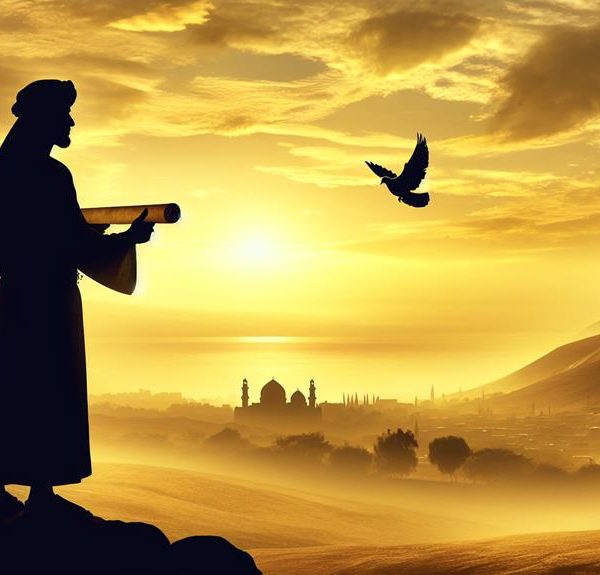
Sign up